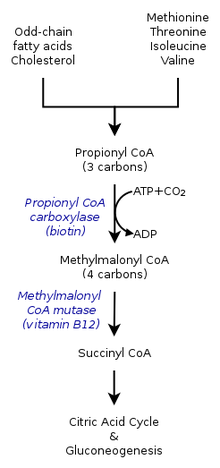Propionic acidemia
| Propionic acidemia | |
|---|---|
| Classification and external resources | |
 | |
| ICD-10 | E71.1 |
| ICD-9 | 270.3 |
| OMIM | 606054 |
| DiseasesDB | 29673 29904 |
| eMedicine | ped/1906 |
Propionic acidemia, also known as propionic aciduria, propionyl-CoA carboxylase deficiency and ketotic glycinemia,[1] is an autosomal recessive[2] metabolic disorder, classified as a branched-chain organic acidemia.[3]
The disorder presents in the early neonatal period with progressive encephalopathy. Death can occur quickly, due to secondary hyperammonemia, infection, cardiomyopathy, or basal ganglial stroke.[4]
Propionic acidemia is a rare disorder that is inherited from both parents. Being autosomal recessive, neither parent shows symptoms, but both carry a defective gene responsible for this disease. It takes two faulty genes to cause PA, so there is a 1 in 4 chance for these parents to have a child with PA.
Pathophysiology
In healthy individuals, the enzyme propionyl CoA carboxylase converts propionyl CoA to methylmalonyl CoA. This is one step in the process of converting certain amino acids and fats into sugar for energy. Individuals with PA cannot perform this conversion because the enzyme propionyl CoA carboxylase is nonfunctional. The essential amino acids; isoleucine, valine,threonine, and methionine and odd-chain fatty acids are simply converted to propionyl CoA, before the process stops, leading to a buildup of propionyl CoA. Instead of being converted to methylmalonyl CoA, propionyl CoA is then converted into propionic acid, which builds up in the bloodstream. This in turn causes an accumulation of dangerous acids and toxins, which can cause damage to the organs.
In many cases, PA can damage the brain, heart, and liver, cause seizures, and delays to normal development like walking and talking. During times of illness the affected person may need to be hospitalized to prevent breakdown of proteins within the body. Each meal presents a challenge to those with PA. If not constantly monitored, the effects would be devastating. Dietary needs must be closely managed by a metabolic geneticist or metabolic dietician.
Mutations in both copies of the PCCA or PCCB genes cause propionic acidemia.[5] These genes are responsible for the formation of the enzyme propionyl-CoA carboxylase (EC 6.4.1.3), referred to as PCC.
PCC is required for the normal breakdown of the essential amino acids; valine, isoleucine, threonine, and methionine, as well as certain odd-chained fatty-acids. Mutations in the PCCA or PCCB genes disrupt the function of the enzyme, preventing these acids from being metabolized. As a result, propionyl-CoA, propionic acid, ketones, ammonia, and other toxic compounds accumulate in the blood, causing the signs and symptoms of propionic acidemia.
Symptoms
Propionic acidemia is characterized almost immediately in newborns. Symptoms include poor feeding, vomiting, dehydration, acidosis, low muscle tone (hypotonia), seizures, and lethargy. The effects of propionic acidemia quickly become life-threatening.
Genetic prevalence
Propionic acidemia is inherited in an autosomal recessive pattern and is found in about 1 in 35,000[5] live births in the United States. The condition appears to be more common in Saudi Arabia,[6] with a frequency of about 1 in 3,000.[5] The condition also appears to be common inAmish, Mennonite and other populations where inbreeding is common.[7]
Management
Patients with propionic acidemia should be started as early as possible on a low protein diet. In addition to a protein mixture that is devoid of methionine, threonine, valine, and isoleucine, the patient should also receive L-carnitine treatment and should be given antibiotics 10 days per month in order to remove the intestinal propiogenic flora. The patient should have diet protocols prepared for him with a “well day diet” with low protein content, a “half emergency diet” containing half of the protein requirements, and an “emergency diet” with no protein content. These patients are under the risk of severe hyperammonemia during infections that can lead to comatose states.[8]
Liver transplant is gaining a role in the management of these patients, with small series showing improved quality of life.




No comments:
Post a Comment